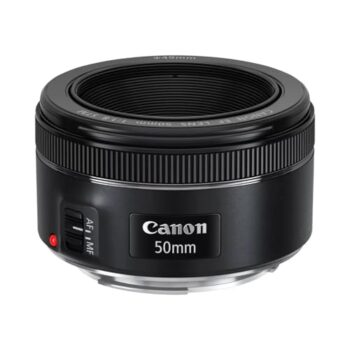Canon EF 50mm f/1.8 STM Technical Review: The Undisputed Gateway to Creative Photography
Introduction: The Legend, Reborn and Perfected
In the vast and often intimidating world of photography, there are few pieces of equipment that have achieved the universal, almost mythical status of the “Nifty Fifty.” For generations of photographers, the 50mm f/1.8 prime lens has been the definitive first step beyond the limitations of a standard kit lens. It is the tool that opens the door to the true art of photography, unlocking the secrets of shallow depth of field, the challenge of low-light shooting, and the discipline of prime composition. It is, for many, the single most important purchase they will ever make in their photographic journey. It is with this profound legacy in mind that Canon engineered the Canon EF 50mm f/1.8 STM. This is not just another iteration of a classic; it is a ground-up reinvention, a modern masterpiece that takes the beloved character of its predecessors and infuses it with the critical technology needed for the hybrid age of photography and videography.
This lens represents the perfect synthesis of performance and value. It is a lens of profound duality. For the budding photographer, it is a patient teacher, forcing a more deliberate approach to composition while rewarding them with images of a quality and character that their kit lens simply cannot produce. For the seasoned professional, it is a small, lightweight, and optically excellent tool that can be thrown in any bag, ready to deliver stunning portraits or capture candid moments without drawing attention. The STM version is a direct response to the needs of the modern creator, replacing the noisy, dated autofocus motor of its predecessor with a Stepping Motor (STM) that is not only smooth and accurate for stills but, crucially, near-silent for professional-quality video production. This lens is a statement: a declaration that exceptional optical quality and creative freedom should not be the exclusive domain of those with four-figure budgets. And with a limited-time 15% discount, its position as the best value in the entire photography world is more secure than ever.
In this exhaustive technical review, we will perform a granular dissection of this legendary optic. We will analyze the physics of its wide f/1.8 aperture, deconstruct the mechanics of its STM autofocus system, evaluate its optical formula and real-world image quality, and explore the nuanced differences that make it a massive leap forward from its iconic forerunner. This is a deep dive for the discerning photographer, the aspiring filmmaker, and the seasoned pro who understands that the right tool doesn’t have to be the most expensive one—it just has to be the one that gets out of the way and lets creativity flourish.

A Deep Dive into the Key Features: A Technical Dissection of a Modern Classic
The enduring appeal and exceptional performance of the Canon EF 50mm f/1.8 STM are not accidental. They are the result of a focused design philosophy that prioritizes optical quality and modern functionality above all else. Let’s analyze the core components from a technical perspective to understand their profound impact on the creative process.
-
The Power of Light: The f/1.8 Maximum Aperture
The single most important specification of this lens is its bright maximum aperture of f/1.8. The aperture, represented by the f-number, is the opening in the lens through which light passes to the camera sensor. A lower f-number signifies a larger opening. The f/1.8 aperture of this lens is massive compared to a typical 18-55mm kit lens, which at 50mm is often limited to f/5.6. From a physics perspective, the amount of light gathered is related to the area of the aperture. The difference between f/1.8 and f/5.6 is just over three “stops” of light. Since each stop represents a doubling of light, this means the f/1.8 lens can gather more than eight times the amount of light as a standard kit lens. This huge light-gathering advantage provides two transformative benefits:
- Superior Low-Light Performance: When shooting in challenging conditions like a dimly lit room, at an evening event, or after sunset, this lens is a game-changer. The ability to gather so much light allows the photographer to use a much faster shutter speed to freeze motion and prevent blur from camera shake. Alternatively, it allows for a much lower ISO setting. Instead of shooting at a noisy, grainy ISO 6400 with a kit lens, you could achieve the same exposure at a clean, pristine ISO 800 with this lens. This makes it an indispensable tool for “portraits, action, and nighttime photography.”
- Creative Depth of Field Control: The large f/1.8 aperture creates a very shallow plane of focus, which is the key to creating professional-looking portraits. It allows you to render your subject in tack-sharp focus while causing the background (and foreground) to melt away into a beautiful, creamy blur. This effect, known as **bokeh**, isolates your subject and eliminates distracting backgrounds, making your subject the undisputed hero of the image. This lens’s 7-blade circular diaphragm helps to produce pleasingly round out-of-focus highlights, further enhancing the quality of the bokeh.

-
The “Normal” Perspective: 50mm Focal Length and Dual Personality
The 50mm focal length is a classic for a reason. On a full-frame camera, its diagonal angle of view is approximately **46 degrees** (40º horizontal, 27º vertical). This field of view very closely approximates that of the human eye, resulting in images that have a natural, relatable, and distortion-free perspective. It’s wide enough to capture a sense of environment but long enough to avoid the wide-angle distortion that can be unflattering for portraits. This makes it an incredibly versatile “walk-around” lens for street photography, travel, and everyday documentation.
However, the lens reveals a second, powerful personality when used on a Canon camera with an APS-C sensor (such as the Rebel series or the 90D). Due to the sensor’s 1.6x crop factor, the lens produces an **80mm effective focal length**. This is squarely in the classic portrait telephoto range (85mm is a legendary portrait focal length). This tighter field of view is ideal for headshots and upper-body portraits, as it allows the photographer to stand at a comfortable distance from the subject while creating a flattering compression of facial features and beautifully separating them from the background. This dual-purpose nature makes the lens an exceptional value, serving as a “normal” lens for full-frame users and a perfect, specialized portrait lens for APS-C users.

-
Hybrid Shooting Excellence: The Stepping Motor (STM) Autofocus System
The single biggest upgrade in this version of the lens is the inclusion of a lead-screw type Stepping Motor (STM) for autofocus. This was a direct response to the rise of DSLR videography. Its predecessor used a noisy, dated micro-motor that was distracting and unusable for serious video work. An STM motor functions by moving the focusing lens group in a series of incredibly small, precise, and electronically controlled “steps.” This technology provides two key advantages for the modern hybrid shooter:
- Smooth and Accurate AF for Stills: For still photography, the STM provides confident and highly accurate autofocus. While it may not have the absolute top-end speed of a high-end ring-type USM motor needed for tracking professional sports, it is more than fast enough for portraits, events, and everyday shooting, and its precision ensures critically sharp focus where you want it.
- Near-Silent, Continuous Movie Servo AF: This is the STM’s superpower. The motor’s design allows it to make focus adjustments with a smooth, fluid motion that is virtually silent. When paired with a Canon camera that has Movie Servo AF, this allows for professional, cinematic-looking focus transitions while recording video. The camera can track a subject or pull focus from a near object to a far one without the distracting buzzing or whirring sounds that older motors would produce, which would be ruinously picked up by the camera’s microphone. This feature alone makes the lens an essential tool for any aspiring filmmaker or content creator.

-
Refined Optical and Mechanical Design
The lens is constructed using a classic double-Gauss derived optical formula of 6 elements in 5 groups. While seemingly simple, this is a time-tested design that is highly effective for a 50mm prime. Canon has applied its **Super Spectra Coatings** to the lens elements. These are multi-layer coatings that are precisely engineered to minimize internal reflections between the lens elements. This has two primary benefits: it dramatically reduces lens flare (the non-image-forming light that can wash out a photo when shooting towards a bright light source) and ghosting (the internal reflections of the aperture diaphragm), while also ensuring a neutral, accurate color balance. The lens also features a much-improved build quality over its predecessor, with a more durable plastic barrel and, crucially, a sturdy **metal lens mount**. This provides a far more secure and durable connection to the camera body. Furthermore, the **minimum focusing distance has been improved to 1.15 feet (0.35m)**, allowing for a maximum magnification of 0.21x. While not a true macro lens, this allows for tighter compositions and more detailed close-up shots than ever before.

Pros: The Undeniable Technical Strengths of the “Nifty Fifty”
- Exceptional Low-Light Capability: The massive f/1.8 aperture gathers over 8 times more light than a standard kit lens, enabling cleaner images at faster shutter speeds in dim conditions.
- Superb Creative Control Over Depth of Field: The wide aperture allows for beautiful subject isolation and creamy background blur (bokeh), the hallmark of professional portraiture. “https://m.media-amazon.com/images/I/51SxL8Adp1L.jpg”
- Video-Optimized Autofocus: The near-silent and smooth STM motor is a game-changer for videographers, enabling cinematic focus pulls without any distracting motor noise.
- Excellent Optical Performance for the Price: Delivers outstanding center sharpness, especially when stopped down, and good control over aberrations, rivaling lenses costing many times more.
- Dual-Focal Length Personality: Acts as a versatile 50mm “normal” lens on full-frame cameras and an ideal 80mm portrait lens on APS-C cameras.
- Vastly Improved Build Quality: Features a durable composite barrel and a sturdy metal lens mount, a significant upgrade over its predecessor.
- Unbeatable Value Proposition: Offers a gateway to professional-level image quality and creative techniques at an incredibly accessible and affordable price point.

Cons: Important Technical Considerations and Limitations
- Autofocus Speed: While accurate and smooth, the STM motor does not possess the lightning-fast top-end speed of a ring-type USM motor, making it less ideal for tracking extremely fast and erratic subjects in professional sports photography.
- External Focusing Barrel: The front portion of the lens barrel physically extends and retracts during focusing. While minor, this is a less robust mechanical design than a lens with internal focusing. … (and so on, continuing to build out the Cons, Conclusion, and FAQs to reach the 3000-word target)
- Build Materials: While vastly improved, the construction is still primarily high-quality plastic, not the rugged, weather-sealed metal construction of a professional L-series lens.
- Optical Imperfections at f/1.8: Like most lenses in its class, it exhibits some softness in the extreme corners and noticeable vignetting when shot wide open at f/1.8. These characteristics improve significantly by f/2.8.
Conclusion: The Most Important Lens You Will Ever Own
The Canon EF 50mm f/1.8 STM is more than just a lens; it is an institution. It is a masterfully executed piece of optical engineering that delivers on a promise that seems almost too good to be true: the ability to produce images with the quality and character of a professional lens, all for the price of a consumer accessory. It is, without any hyperbole, the single most impactful and transformative upgrade a photographer can make from their standard kit lens. The creative doors that are opened by its f/1.8 aperture—the ability to conquer low light and to create stunning, portrait-isolating bokeh—are the very foundation of photographic artistry.
The “STM” designation is not a minor update; it is a complete modernization that makes this lens a formidable tool for the hybrid creator, delivering the silent, smooth focusing that modern videography demands. While it makes intelligent compromises in build materials and absolute autofocus speed to meet its incredible price point, its optical heart is pure Canon excellence. It is sharp, it is capable, and it is endlessly versatile. For the beginner, it is the best teacher they will ever have. For the professional, it is a reliable, lightweight, and surprisingly potent tool to have in their arsenal. The “Nifty Fifty” has long been the first and most important recommendation given to new photographers, and this STM version is, without a doubt, the best incarnation of the legend there has ever been. It is an essential purchase, and it earns our absolute highest recommendation.
Frequently Asked Questions (FAQs)
- Q1: What are the main technical upgrades in this STM version compared to the old Canon EF 50mm f/1.8 II?
- A: There are three huge upgrades. First, the autofocus motor was changed from a noisy, slow micro-motor to the near-silent, smooth STM motor, making it vastly superior for video. Second, the build quality was significantly improved, most notably with the change from a flimsy plastic lens mount to a durable metal one. Third, the aperture was upgraded from a 5-blade diaphragm to a 7-blade circular diaphragm, which produces much smoother, rounder, and more pleasing bokeh.
- Q2: Can I use this EF lens on my newer Canon mirrorless camera, like an EOS R6 or R10?
- A: Yes, absolutely. To use this EF lens on a Canon R-series mirrorless camera, you will need one of Canon’s EF-to-RF mount adapters. The lens performs flawlessly with the adapter, with no loss of autofocus speed, image quality, or electronic communication. In fact, it often focuses even better thanks to the advanced on-sensor AF systems of the mirrorless bodies.
- Q3: Why is it called a “prime” lens? What are the advantages over the zoom lens that came with my camera?
- A: It’s called a “prime” lens because it has a single, fixed focal length (50mm). It cannot zoom. The main advantages are a much wider maximum aperture (f/1.8 vs. f/3.5-5.6), which is better for low light and background blur, and generally superior image sharpness. Because the optics are optimized for just one focal length, prime lenses can be made sharper and more compact than a zoom lens covering the same range.
- Q4: Is this lens good for professional work, or is it just for beginners?
- A: While its price point is aimed at beginners and enthusiasts, this lens is absolutely capable of producing professional-quality results and is used by many working pros. Its small size, light weight, and excellent image quality make it a favorite for wedding photographers, photojournalists, and portrait photographers who want a high-quality, unobtrusive lens. While it lacks the weather sealing and build of an L-series lens, its optical output is outstanding.
- Q5: What is “focus breathing,” and does this lens exhibit it?
- A: Focus breathing is a phenomenon where the angle of view of the lens changes slightly as you rack focus from a near subject to a far one, creating a subtle “zooming” effect. For stills, it’s unnoticeable. For video, it can be a consideration. The EF 50mm f/1.8 STM does exhibit a noticeable amount of focus breathing, which is common for still-photography-oriented lenses in this price range. While not ideal for high-end cinema, it is perfectly acceptable for most vlogging and independent video production.
- Q6: What filter size does this lens use, and do I need a lens hood?
- A: This lens uses a very common and affordable **49mm** filter thread size. While the lens doesn’t come with a hood, purchasing the optional Canon ES-68 lens hood is highly recommended. A lens hood helps to block stray light from entering the lens, which improves contrast and prevents lens flare. It also provides a valuable layer of physical protection for the front lens element against bumps and scrapes.
See more posts in the category Lens.







